Overcoming Digital Addiction Steps Achieve Healthy Online-Offline Balance
Overcoming Digital Addiction: Practical Steps to Achieve a Healthy Online-Offline Balance
In the rapidly evolving digital landscape of the 21st century, it has become increasingly common for individuals to find themselves entangled in the web of digital addiction. From compulsive social media scrolling to incessant checking of emails, the prevalence of digital addiction has become a concerning issue, affecting both mental and physical well-being. As technology continues to advance, it is essential to recognize the significance of maintaining a healthy balance between our online and offline lives. In this comprehensive guide, we delve into practical steps that can aid in overcoming digital addiction, enabling individuals to cultivate a sustainable and harmonious relationship with technology.
 |
| Overcoming Digital Addiction Steps Achieve Healthy Online-Offline Balance |
Understanding Digital Addiction: A Multifaceted Phenomenon
Before delving into the strategies for overcoming digital addiction, it is imperative to comprehend the complexities and nuances of this modern-day predicament. Digital addiction encompasses a range of behaviors that impede an individual's ability to manage their online activities in a balanced manner. While the term "digital addiction" is relatively recent, its impacts on mental health and overall well-being have been extensively studied by psychologists, researchers, and experts in the field.
Key Factors Contributing to Digital Addiction
- Ubiquitous Connectivity: The pervasive nature of digital devices and the seamless accessibility of the internet have made it challenging for individuals to disconnect from the online world.
- Social Validation: The quest for social validation and recognition on various digital platforms has led to an incessant need for online engagement and validation.
- Fear of Missing Out (FOMO): The fear of missing out on the latest news, trends, and social gatherings often triggers a compulsive need to remain constantly connected to digital devices.
- Design of Digital Platforms: Many digital platforms are specifically designed to foster addictive behavior, employing techniques such as infinite scrolling and push notifications to keep users engaged for longer periods.
Practical Steps to Overcome Digital Addiction
Addressing digital addiction requires a concerted effort to reevaluate one's relationship with technology and establish healthier online and offline habits. By implementing the following practical steps, individuals can gradually reclaim control over their digital consumption and foster a more balanced lifestyle.
1. Establish Clear Boundaries
Setting clear boundaries is fundamental to regaining control over digital consumption. Consider implementing the following strategies:
- Define specific time slots for engaging with digital devices and stick to a predetermined schedule.
- Designate tech-free zones in your home to encourage offline interactions and foster a tech-free environment during meals and social gatherings.
2. Practice Mindful Consumption
Cultivating mindfulness in the use of digital devices can significantly mitigate the risk of falling into addictive patterns. Incorporate the following practices into your daily routine:
- Consciously monitor your screen time and track your digital usage using dedicated apps and built-in screen time features.
- Practice mindful browsing by focusing on purpose-driven online activities and avoiding aimless scrolling.
3. Foster Real-World Connections
Nurturing meaningful relationships outside of the digital sphere is essential for combatting digital addiction. Consider the following approaches to foster real-world connections:
- Allocate dedicated time for face-to-face interactions with family and friends, emphasizing the importance of in-person communication and genuine connections.
- Participate in community events and group activities that encourage offline engagement and social interaction.
4. Embrace Digital Detox Periods
Engaging in regular digital detox periods can rejuvenate the mind and body, fostering a healthier relationship with technology. Consider the following techniques for an effective digital detox:
- Plan periodic digital detox weekends or holidays, during which you disconnect from all digital devices and immerse yourself in nature or engage in offline hobbies.
- Integrate relaxation techniques such as meditation, yoga, and mindfulness exercises to alleviate digital stress and promote holistic well-being.
5. Optimize Digital Environment
Creating a conducive digital environment can significantly reduce the likelihood of succumbing to digital addiction. Implement the following strategies to optimize your digital environment:
- Customize device settings to minimize distractions, such as disabling notifications and implementing grayscale mode to reduce screen appeal.
- Utilize website blockers and productivity apps to limit access to specific websites and applications that contribute to excessive screen time.
Assessing Progress: Tracking and Evaluating Behavioral Changes
Assessing your progress in overcoming digital addiction is crucial for maintaining long-term success. Consider tracking the following key metrics to evaluate behavioral changes and monitor your journey toward achieving a healthier online-offline balance:
| Metric | Measurement Method | Frequency of Assessment |
|---|---|---|
| Screen Time | Utilize digital tracking apps | Weekly |
| Online Engagement | Monitor social media activity | Bi-weekly |
| Real-world Interactions | Maintain a journal of in-person interactions | Monthly |
Conclusion: Striking a Harmonious Balance in the Digital Era
Overcoming digital addiction necessitates a holistic approach that prioritizes mindfulness, self-discipline, and the cultivation of meaningful real-world connections. By implementing the practical steps outlined in this guide and consistently reassessing your progress, you can gradually achieve a healthier online offline balance. Remember, the journey to overcoming digital addiction is a gradual process that requires patience, perseverance, and a commitment to prioritizing your overall well-being in an increasingly digitized world. By embracing these strategies, you can reclaim control over your digital habits and foster a more harmonious relationship with technology.